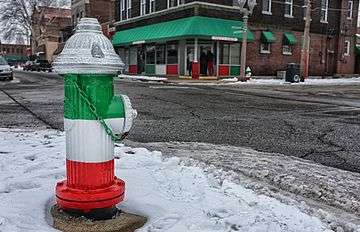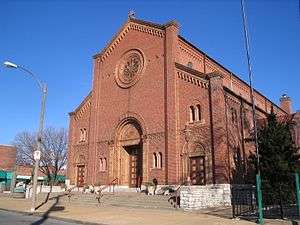The Hill, St. Louis
| The Hill | |
|---|---|
| Neighborhood of St. Louis | |
 | |
|
Location of The Hill within St. Louis | |
| Country | United States |
| State | Missouri |
| City | St. Louis |
| Wards | 10, 24 |
| Area | |
| • Total | 0.97 sq mi (2.5 km2) |
| Population (2010)[1] | |
| • Total | 2,443 |
| • Density | 2,500/sq mi (970/km2) |
| ZIP code(s) | Part of 63110 |
| Area code(s) | 314 |
| Website | stlouis-mo.gov |

The Hill is a neighborhood within St. Louis, Missouri, located on high ground south of Forest Park. The official boundaries of the area are Manchester Avenue (Route 100) on the north, Columbia and Southwest Avenues on the south, South Kingshighway Boulevard on the east, and Hampton Avenue on the west.
The Hill has an Italian American majority population, and is home to many Italian restaurants and businesses.
Its name is due to its proximity to the highest point of the city, formerly named St. Louis Hill, which is a few blocks south, at the intersection of Arsenal Street and Sublette Avenue. The intersection borders Sublette Park, the former site of the Social Evil Asylum built there in 1873.

History
Italians, mainly from the north and especially from the northern Italian region of Lombardy, immigrated and settled in the area starting in the late 19th century, attracted by jobs in nearby plants established to exploit deposits of clay discovered by immigrants in the 1830s.
With the growth of Italian immigration came the growth in the influence of the Roman Catholic Church such that the Parish of Our Lady, Help of Christians, was founded in the downtown area of St. Louis in 1900 to serve primarily recent Sicilian immigrants, while the Parish of St. Ambrose was founded by members of St. Aloysius Gonzaga Parish [2] in what later came to be known as the Hill in 1903 to serve primarily the recent Lombard immigrants. By the time the new church of St. Ambrose was built in 1926, the Parish had already been a force in the area for over 20 years. The structure, designed by architect Angelo Corrubia[3], is modeled after Sant'Ambrogio Church in Milan, in an Lombard Romanesque Revival style of brick and terra cotta. It became the parish church for the area in 1955, after 30 years of focusing on those of Italian heritage. When Our Lady, Help of Christians, Parish closed in 1975, St. Ambrose became the center of Catholic life among many Italian-Americans in the St. Louis area.
That heritage remains evident today. As of May 2003, about three-quarters of the residents are Italian-Americans, helped perhaps by the practice of rarely listing homes on the open market.[4] The neighborhood is home to a large number of locally renowned Italian-American restaurants, bakeries, grocery stores, salons, and two bocce gardens.

Baseball greats Yogi Berra and Joe Garagiola, Sr. grew up on the Hill; their boyhood homes are across the street from each other on Elizabeth Avenue. Four of the five St. Louisans on the US soccer team that defeated England in the 1950 FIFA World Cup came from here, a story that is told in The Game of Their Lives, a book ( ISBN 0-8050-3875-2) and 2005 film of the same title (released on DVD as The Miracle Match).
According to Garagiola's book Baseball Is a Funny Game, the Hill was called "Dago Hill." Blues singer Luella Miller recorded "Dago Hill Blues" about the area in 1926[5] and Charlie Patton referenced it in his 1934 single "Love My Stuff;"[6] at the time, the area was of mixed Italian and African-American ethnicity. North Carolina blues man Blind Boy Fuller makes reference to the Hill in his song "Log Cabin Blues". Georgia Tom and Tampa Red also sing of the Hill in their song "You Can't Get That Stuff No More".
Demographics
| Historical population | ||
|---|---|---|
| Year | Pop. | ±% |
| 2000 | 2,648 | — |
| 2010 | 2,443 | −7.7% |
In 2010 The Hill's racial makeup was 93.7% White, 3.4% Black, 0.2% Native American, 0.8% Asian, 1.4% Two or More Races, and 0.3% Some Other Race. 1.3% of the people were of Hispanic or Latino origin.[7]
Italians in St Louis today
As of 2018 there are 1,500 native born Italians living in St Louis, some of whom live in The Hill neighborhood but also throughout the St Louis metropolitan region. The Comunita' degli Italiani - St Louis, an organization which promotes the Italian language and culture, has several popular events which include Carnevale which occurs every February and Ferragosto which occurs each August. The Church of St Ambrose still has a Mass in Italian each month.
See also
- Ozark Highlands AVA, winemaking region in Missouri started by Italian immigrants
- St. Louis cuisine
- Toasted ravioli, a local dish made from fried Italian ravioli
References
- ↑ "Census Summary By Neighborhoods". Archived from the original on 26 June 2009. Retrieved 12 November 2017.
- ↑ "Preserving St. Aloysius Gonzaga Church - Preservation Research Office". preservationresearch.com. Retrieved 12 November 2017.
- ↑ Mormino, Gary Ross (2002). Immigrants on the Hill: Italian-Americans in St. Louis, 1882-1982. University of Missouri Press. ISBN 9780826214058.
- ↑
- ↑ "Honey, Where You Been So Long?". prewarblues.org. Retrieved 12 November 2017.
- ↑ Robert Springer, Nobody Knows Where the Blues Come From: Lyrics and History. Univ of Mississippi Press, p.65
- ↑ "Census". dynamic.stlouis-mo.gov. Retrieved 12 November 2017.
External links
- The Community of Italians in St Louis (bilingual)
- Italian organizations in St. Louis (bilingual)
- The City of St. Louis Hill neighborhood website
- thehillstlouis.com | Guide to Restaurants, Markets, Retail, & Services
- Hill2000.org | The Website of the Hill 2000 Neighborhood Association
- Hill Business Association Website
- St. Ambrose Parish